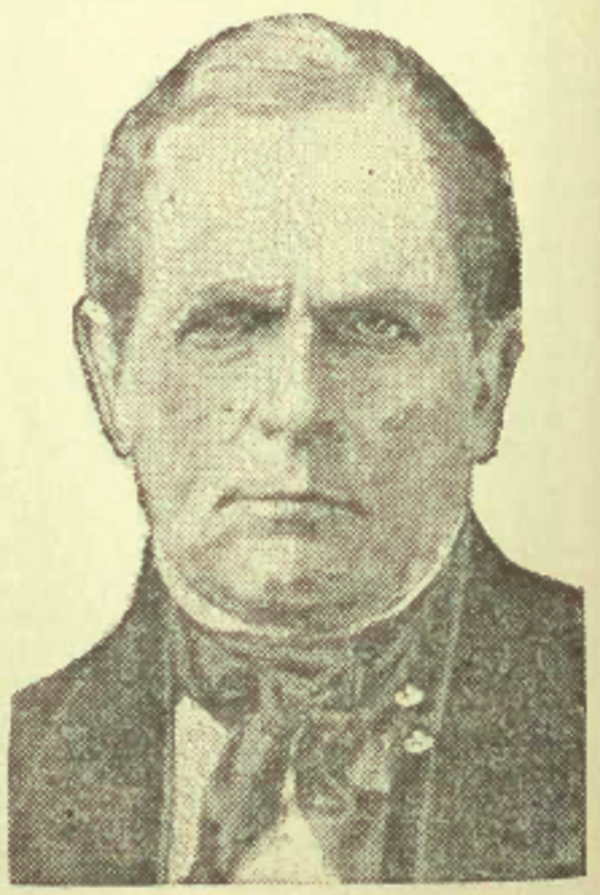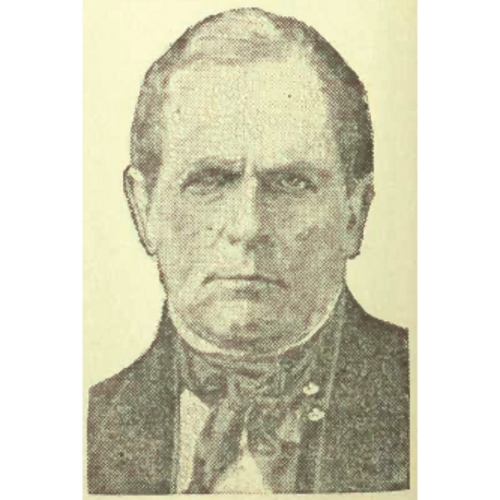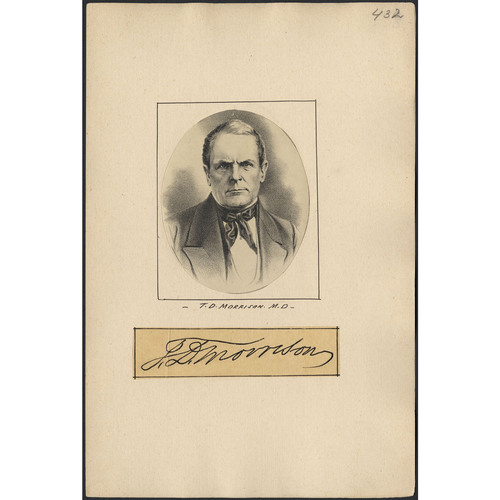As part of the funding agreement between the Dictionary of Canadian Biography and the Canadian Museum of History, we invite readers to take part in a short survey.

Source: Courtesy of Wikimedia Commons
MORRISON, THOMAS DAVID, clerk, physician, and politician; b. c. 1796, son of William Morrison; m. 2 Sept. 1818 Effie Gilbert, née Patrick, in York (Toronto); d. 19 March 1856 in Toronto.
Thomas David Morrison was born at Quebec, where his father was senior clerk of works in the Royal Engineers department at the time of his death in 1842. During the War of 1812 the young Morrison served as a clerk in the purveyor’s branch of the British army’s medical department; following his reduction he became, by 1816, a clerk in the office of the surveyor general in York. In 1818 he married the sister of William Poyntz Patrick, a clerk in the House of Assembly and a prominent Methodist. Originally an Anglican, Morrison participated that year in the organization of the first Methodist church in York. In June 1822 he was dismissed by Surveyor General Thomas Ridout* for uttering “languages” and advancing “opinions very unbecoming a person employed in one of His Majesty’s public offices.” Some time after his dismissal he reputedly travelled to the United States to pursue a medical education. Returning to York, he was examined on 5 July 1824, by Christopher Widmer, Grant Powell*, and Robert Charles Horne* of the Medical Board of Upper Canada, and was licensed to practise “Physic, Surgery and Midwifery.”
Morrison prospered as a physician, establishing a large practice in the town as well as “in the country up Yonge Street.” An active member of the profession, he served on the ad hoc board of health set up in York during the cholera outbreak of 1832, and was courageously involved in fighting the more virulent outbreaks of 1834. In 1832 he had joined his friends and fellow physicians William Warren Baldwin* and John E. Tims in administering the York Dispensary, which opened on 22 August. It lasted about eight months, during which time it prescribed and distributed free medicine to 746 patients, at a cost of £118 3s. 4d. In early 1836 Morrison was appointed to the Medical Board, a position he held until the winter of 1837–38. Active in other areas of the community, he served as vice president of the bible society, trustee of the York General Burying Ground, and common school trustee.
In politics Morrison played an important role in the reform agitation of the 1820s, though never with the driving spirit of William Lyon Mackenzie* or with the intellectual input of Baldwin, John Rolph*, or Marshall Spring Bidwell*. Morrison was a talented orator, and therefore much in demand in a highly politicized community where public meetings and demonstrations were occurring with increasing regularity.
Morrison first sought public office, for the town of York, in the provincal election of 1828, amid the furore caused by Lieutenant Governor Sir Peregrine Maitland’s dismissal of Judge John Walpole Willis*. A committee of radical reformers, including Mackenzie, Jesse Ketchum*, and Francis Collins*, assembled in York in January to select a candidate to oppose Attorney General John Beverley Robinson*, a leading figure in the dismissal of Willis. Although some reformers put forward the more moderate Robert Baldwin, Morrison was chosen. William Warren Baldwin, Robert’s father and himself a candidate in Norfolk, nominated Morrison on the hustings, evidence perhaps of the solidarity and resolve of the reformers. Unfortunately, their exertions in York were to no avail: Robinson was declared elected by 110 votes to 93. The return was challenged by Morrison on the grounds of illegal votes and reputed irregularities on the part of the returning officer, William Botsford Jarvis*. Although Morrison’s case was eloquently argued by the Baldwins, Robinson’s election was upheld. The reformers, however, had won a majority of seats throughout the province, which they enjoyed until 1830 and again in 1834–36.
In the first municipal elections for the city of Toronto, held in 1834, Morrison was elected alderman for St Andrew’s Ward on a reform-dominated council. During the negotiations within council over who would be mayor, he voted to support the nomination of Mackenzie. Having assumed the role of intermediary, however, he was chosen to read to council John Rolph’s letter of resignation as an alderman because he had expected to become mayor. In the provincial election of 1834, in which the reformers swept the four ridings of York County, Morrison finally gained a seat, for 3rd York. Returned as an alderman in 1835 and again in 1836, when the reformers regained the majority in council they had lost the previous year, he was elected in January 1836 to a one-year term as mayor.
Although during Morrison’s mayoralty, council spent some of its time on municipal business such as building a water-works and lighting the streets with gas, like previous councils it was preoccupied with provincial political controversies [see William Lyon Mackenzie]. In February 1836 Morrison, as mayor, signed an optimistic address of welcome to the new lieutenant governor, Sir Francis Bond Head*, who, it was hoped, would help secure reform. When John Rolph, John Henry Dunn, and Robert Baldwin resigned from the Executive Council the next month and Mackenzie was defeated in the provincial election in July (the result, he claimed, of the lieutenant governor’s having “unduly interfered with the election”), the reformers once again used city council as a platform. Morrison himself had been re-elected to the House of Assembly that summer and he did not serve on city council again after the end of his mayoralty.
As the demands for reform intensified in 1837, Morrison continued to play a leading public role, especially in the assembly. Among the radicals, however, he was beginning to hold back. He attended the meeting of reformers at John Doel*’s brewery in July and seconded a motion by Mackenzie congratulating the reformers in Lower Canada. Then, though hesitant, he signed the reform declaration drafted at that meeting and was made a member of the Central Vigilance Committee. He chaired a second meeting at Doel’s brewery in October, at which time he refused to support Mackenzie’s plan for revolt.
Morrison, like other leading reformers in the city such as Rolph, Bidwell, and William Warren Baldwin (with whom he probably consulted), was unwilling to participate openly in Mackenzie’s plan to raise a force in the country and march on Toronto. According to Charles Lindsey*, he “remained in his house” during the abortive uprising. Upon the collapse of the rebellion, however, he was arrested by the militia on 6 December and held without bail, remaining in jail until his trial the following spring.
Morrison’s trial for high treason opened on 24 April 1838 under the pall created by the executions of Samuel Lount* and Peter Matthews*, who had been hanged 12 days previously. Morrison was indeed fighting for his life. Moreover, his defence, led by Robert Baldwin, was exacerbated by Mackenzie’s pronouncements from across the border and by the compromising evidence of Morrison’s signature on the reform declaration of July 1837. In the end he was found not guilty, though the jury enquired about finding him guilty of misprision of treason, a lesser crime. The prospect of being tried on this charge terrified Morrison, who, according to John Ryerson*, believed that since “they were bent on his destruction & that they would accomplish it, he had better leave as Mr. Bidwell had done.” On 29 April 1838 Morrison left Toronto for the United States.
He remained in exile for five years, settling in upstate New York near Batavia, where after some time he was able to establish himself in medical practice. But he was clearly not happy and toyed with the idea of moving to Michigan. In 1843, following the Canadian government’s declaration of amnesty, he returned to Toronto and re-established his practice. Unlike Rolph, and later Mackenzie, he did not again seek public office. Instead he concentrated on his medical career, serving on hospital boards and lecturing at Rolph’s Toronto School of Medicine. In 1851 Morrison was appointed to the reconstituted Medical Board as part of Rolph’s machinations against the University of Toronto’s medical faculty [see Christopher Widmer]. He died of palsy at his home on Adelaide Street on 19 March 1856.
Morrison’s political career was inextricably connected with the fortunes of the provincial reform movement that was crushed in 1837. At the height of his career, in 1836–37, he played an important but not pivotal role in shaping events of the day. He was a respectable supporter of the great ones around him who, unlike Morrison, survived the defeat of December 1837.
Academy of Medicine (Toronto),
Cite This Article
Victor Loring Russell, “MORRISON, THOMAS DAVID,” in Dictionary of Canadian Biography, vol. 8, University of Toronto/Université Laval, 2003–, accessed April 1, 2025, https://www.biographi.ca/en/bio/morrison_thomas_david_8E.html.
The citation above shows the format for footnotes and endnotes according to the Chicago manual of style (16th edition). Information to be used in other citation formats:
| Permalink: | https://www.biographi.ca/en/bio/morrison_thomas_david_8E.html |
| Author of Article: | Victor Loring Russell |
| Title of Article: | MORRISON, THOMAS DAVID |
| Publication Name: | Dictionary of Canadian Biography, vol. 8 |
| Publisher: | University of Toronto/Université Laval |
| Year of revision: | 1985 |
| Access Date: | April 1, 2025 |




